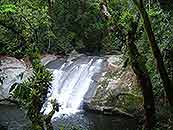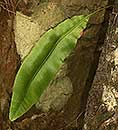Elaphoglossum macropodium (Fée) T. Moore
Synonyms |
Acrostichum macropodium Fée |
|---|---|
Common name |
|
Description |
Rhizome short-creeping, thick, up to 5 mm (without scales); rhizome scales 4-5 mm long, pale brown or orange-tan, concolorous, narrowly lanceolate in outline, apex forming a long drawn out point, margins entire or with hair-like outgrows; phyllopodia present, c. 1 cm long, blackish. Fronds simple, dimorphic, closely spaced, erect to arching, thickly coriaceous. Sterile frond: stipe stramineous to pale green, up to 24 cm long, pale to reddish brown, glabrous with a few scales at the base, articulated at the base; lamina glossy green, (9-)17-37(-42) × 2-8 cm, ovate-lanceolate to narrowly elliptic in outline, apex broadly pointed to rounded, base wedge shaped, margins entire, glabrous except for minute scattered scales on the underside, midrib raised, convex below; veins inconspicuous, 1 mm apart, at 70° angle to the costa; hydathodes absent. Fertile frond: stipe up to 32 cm long, matt pale brown; lamina slightly smaller and narrower than the sterile lamina, very narrowly elliptic in outline, up to 3 × 21 cm, apex pointed, base wedge shaped, with distinct sterile margin; undersurface completely covered with sporangia, intersporangial scales absent. |
Notes | The large frond size and thick rhizome usualy distinguishes this species from others. |
Derivation | makros: large, pous: foot; "with large feet", an allusion to the thick creeping rhizome. |
Habitat | Among boulders in rocky outcrops, on banks or in shade in forest. |
Distribution worldwide | Africa, Comoro Isl. (Grande Comoro), Madagascar, Mauritius, Réunion, Seychelles. |
Distribution in Africa |
|
Growth form |
Epiphytic, lithophytic, terrestrial. |
Literature |
|

